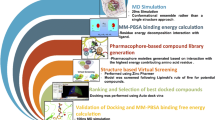Abstract
Comparative molecular field analysis (CoMFA) and comparative molecular similarity indices analysis (CoMSIA) based on three-dimensional quantitative structure–activity relationship (3D-QSAR) studies were conducted on a series (39 molecules) of peptidyl vinyl sulfone derivatives as potential Plasmodium Falciparum cysteine proteases inhibitors. Two different methods of alignment were employed: (i) a receptor-docked alignment derived from the structure-based docking algorithm GOLD and (ii) a ligand-based alignment using the structure of one of the ligands derived from a crystal structure from the PDB databank. The best predictions were obtained for the receptor-docked alignment with a CoMFA standard model (q 2 = 0.696 and r 2 = 0.980) and with CoMSIA combined electrostatic, and hydrophobic fields (q 2 = 0.711 and r 2 = 0.992). Both models were validated by a test set of nine compounds and gave satisfactory predictive r 2 pred values of 0.76 and 0.74, respectively. CoMFA and CoMSIA contour maps were used to identify critical regions where any change in the steric, electrostatic, and hydrophobic fields may affect the inhibitory activity, and to highlight the key structural features required for biological activity. Moreover, the results obtained from 3D-QSAR analyses were superimposed on the Plasmodium Falciparum cysteine proteases active site and the main interactions were studied. The present work provides extremely useful guidelines for future structural modifications of this class of compounds towards the development of superior antimalarials.














Similar content being viewed by others
References
Das MK, Lumb V, Mittra P, Singh SS, Dash AP, Sharma YD (2010) J Antimicrob Chemother 65(6):1258
Martin RE, Kirk K (2004) Mol Biol Evol 21(10):1938
Wiesner J, Ortmann R, Jomaa H, Schlitzer M (2003) Angewandte Chemie 42(43):5274
Sachs J, Malaney P (2002) Nature 415(6872):680
Gardner MJ, Hall N, Fung E, White O, Berriman M, Hyman RW, Carlton JM, Pain A, Nelson KE, Bowman S, Paulsen IT, James K, Eisen JA, Rutherford K, Salzberg SL, Craig A, Kyes S, Chan MS, Nene V, Shallom SJ, Suh B, Peterson J, Angiuoli S, Pertea M, Allen J, Selengut J, Haft D, Mather MW, Vaidya AB, Martin DM, Fairlamb AH, Fraunholz MJ, Roos DS, Ralph SA, McFadden GI, Cummings LM, Subramanian GM, Mungall C, Venter JC, Carucci DJ, Hoffman SL, Newbold C, Davis RW, Fraser CM, Barrell B (2002) Nature 419(6906):498
Padmanaban G (2003) Adv Biochem Eng/Biotechnol 84:123
Teixeira C, Gomes JR, Gomes P (2011) Curr Med Chem 18(10):1555
Rosenthal PJ, Sijwali PS, Singh A, Shenai BR (2002) Curr Pharm Des 8(18):1659
Rosenthal PJ (2004) Int J Parasitol 34(13–14):1489
Subramanian S, Hardt M, Choe Y, Niles RK, Johansen EB, Legac J, Gut J, Kerr ID, Craik CS, Rosenthal PJ (2009) PloS one 4(4):e5156
Batra S, Sabnis YA, Rosenthal PJ, Avery MA (2003) Bioorg Med Chem 11(10):2293
Rosenthal PJ, Olson JE, Lee GK, Palmer JT, Klaus JL, Rasnick D (1996) Antimicrob Agents Chemother 40(7):1600
Singh A, Rosenthal PJ (2001) Antimicrob Agents Chemother 45(3):949
Ettari R, Bova F, Zappala M, Grasso S, Micale N (2010) Med Res Rev 30(1):136
Olson JE, Lee GK, Semenov A, Rosenthal PJ (1999) Bioorg Med Chem 7(4):633
Shenai BR, Lee BJ, Alvarez-Hernandez A, Chong PY, Emal CD, Neitz RJ, Roush WR, Rosenthal PJ (2003) Antimicrob Agents Chemother 47(1):154
MarvinSketch 5.2.2, 2009, ChemAxon (http://www.chemaxon.com)
Sybyl X 1.3, Tripos Software, St. Louis, USA
Jones G, Willett P, Glen RC (1995) J Mol Biol 245(1):43
Jones G, Willett P, Glen RC, Leach AR, Taylor R (1997) J Mol Biol 267(3):727
Kerr ID, Lee JH, Pandey KC, Harrison A, Sajid M, Rosenthal PJ, Brinen LS (2009) J Med Chem 52(3):852
Case DA, Darden TA, Cheatham TE, Simmerling CLI, Wang J, Duke RE, Luo R, Crowley M, Walker RC, Zhang W, Merz KM, Wang B, Hayik S, Roitberg A, Seabra G, Kolossváry KF, Wong KF, Paesani F, Vanicek F, Wu X, Brozell SR, Steinbrecher T, Gohlke H, Yang L, Tan C, Mongan J, Hornak V, Cui G, Mathews DH, Seetin MG, Sagui C, Babin V, Kollman PA (2008) AMBER 10. University of California, San Francisco
Duan Y, Wu C, Chowdhury S, Lee MC, Xiong G, Zhang W, Yang R, Cieplak P, Luo R, Lee T, Caldwell J, Wang J, Kollman P (2003) J Comput Chem 24(16):1999
Kerr ID, Lee JH, Farady CJ, Marion R, Rickert M, Sajid M, Pandey KC, Caffrey CR, Legac J, Hansell E, McKerrow JH, Craik CS, Rosenthal PJ, Brinen LS (2009) J Biol Chem 284(38):25697
Holm L, Park J (2000) Bioinformatics 16(6):566
Perkins R, Fang H, Tong W, Welsh WJ (2003) Environ Toxicol Chem/SETAC 22(8):1666
Golbraikh A, Tropsha A (2002) J Mol Graph Model 20(4):269
Saxena AK, Prathipati P (2003) SAR QSAR Environ Res 14(5–6):433
Gramatica P (2004) Evaluation of different statistical approaches for the validation of quantitative structure-activity relationships. Final report for JRC Contract ECVA-CCR.496576-Z. European Chemicals Bureau, Joint Research Centre, European Commission, Ispra, Italy
Bohm M, Sturzebecher J, Klebe G (1999) J Med Chem 42(3):458
Mittal RR, McKinnon RA, Sorich MJ (2008) J Mol Model 14(1):59
Acknowledgments
We are grateful for the financial support from Fundação para a Ciência e a Tecnologia (FCT, Portugal) to CIQ-UP and CICECO, for the Program Ciência 2007 and for the Post-doctoral fellowship SFRH/BPD/62967/2009 awarded to Cátia Teixeira. We also thank FCT and the European Union (FEDER) for funding through Project refs. PTDC/QUI/65142/2006 and FCOMP-01-0124-FEDER-007418, respectively.
Author information
Authors and Affiliations
Corresponding author
Rights and permissions
About this article
Cite this article
Teixeira, C., Gomes, J.R.B., Couesnon, T. et al. Molecular docking and 3D-quantitative structure activity relationship analyses of peptidyl vinyl sulfones: Plasmodium Falciparum cysteine proteases inhibitors. J Comput Aided Mol Des 25, 763–775 (2011). https://doi.org/10.1007/s10822-011-9459-4
Received:
Accepted:
Published:
Issue Date:
DOI: https://doi.org/10.1007/s10822-011-9459-4




